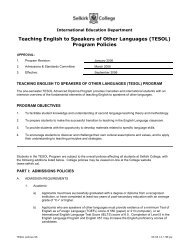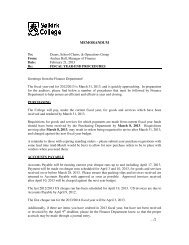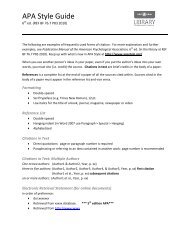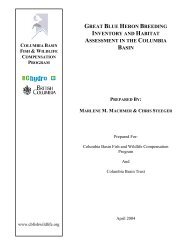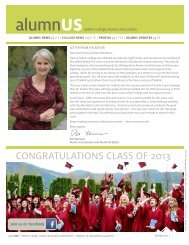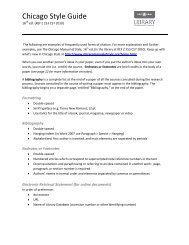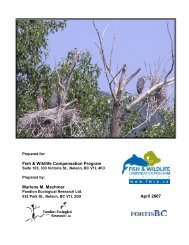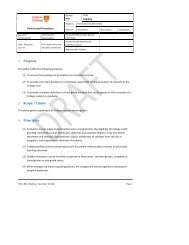selk irk.ca - Selkirk College
selk irk.ca - Selkirk College
selk irk.ca - Selkirk College
Create successful ePaper yourself
Turn your PDF publications into a flip-book with our unique Google optimized e-Paper software.
Cook Training, Professional<br />
COOK 101 A Occupational Skills<br />
Trade Knowledge<br />
Cooks need to understand the personal and<br />
professional expectations of various occupations in<br />
the trade as well as the training and certifi<strong>ca</strong>tion<br />
programs available throughout their <strong>ca</strong>reer.<br />
Safety Standards<br />
There are many hazards present in the kitchen<br />
and a cooks must have a good working knowledge<br />
of recommended safety and fire prevention<br />
procedures.<br />
Menu Planning<br />
Cooks prepare food from a variety of different<br />
menu styles and formats, and should be<br />
familiar with common menu terminology and<br />
composition.<br />
COOK 101 B Stock, Soups and Sauces<br />
Stocks<br />
Correctly prepared stocks are essential to the<br />
preparation of many dishes, and cooks must know<br />
the correct preparation methods and uses of a<br />
variety of types of stock.<br />
Thickening and Binding Agents<br />
A number of different thickening and binding<br />
agents are used in food preparation, and cooks<br />
must select and use them correctly for a variety<br />
of tasks.<br />
Soups<br />
A variety of soups are prepared for use in most<br />
foodservice establishments, and cooks must know<br />
how to correctly prepare the basic types of clear<br />
and thick soups.<br />
Sauces<br />
Sauces are an integral part of many dishes, and<br />
cooks must know how to prepare and correctly<br />
use the leading types of sauces.<br />
COOK 101 C Vegetables and Fruits<br />
Vegetables<br />
Cooks must identify, select and prepare a variety<br />
of vegetables on a daily basis for use in other<br />
dishes and as accompaniments.<br />
Fruit<br />
Fruits and fruit juices are being used more and<br />
more frequently in food preparation. Cooks<br />
must be able to identify, select, and prepare them<br />
correctly<br />
COOK 101 D Starches<br />
Potatoes<br />
A variety of potatoes and potato dishes are used<br />
daily in most food service establishments. Cooks<br />
must identify different varieties of potatoes and<br />
then prepare them in a number of different ways<br />
correctly.<br />
Pastas and Farinaceous Products<br />
Pasta and noodle dishes are an integral part of<br />
many menus. Cooks must be able to correctly<br />
identify, use, and prepare a variety of pasta and<br />
noodle dishes.<br />
Rice, Grains and Legumes<br />
Rice is an essential accompaniment to many<br />
ethnic foods and one of the main starch<br />
components on many menus. Cooks must be able<br />
to correctly identify and prepare rice and a variety<br />
of rice dishes.<br />
COOK 101 E Meat<br />
Cut and Process Meats<br />
Cooks must be able to identify various types of<br />
meat and cut and process them correctly. Cuts of<br />
meat are prepared differently according to their<br />
characteristics, and cooks must be able to identify<br />
the characteristics of each different type.<br />
Cook Meats<br />
Meats are prepared in a variety of ways and cooks<br />
must be able to identify, select, and prepare<br />
different types of meat using dry, moist, and<br />
combination methods.<br />
COOK 101 F Poultry<br />
Cut and Process Poultry<br />
Cooks must be able to identify various types of<br />
poultry and cut and process them correctly. Cuts<br />
of poultry are prepared differently according to<br />
their characteristics, and cooks must be able to<br />
identify the characteristics of each different type.<br />
Cook Poultry<br />
A variety of poultry and poultry products are used<br />
in most foodservice operations, and cooks must be<br />
able to identify, select and prepare them correctly.<br />
COOK 101 G Seafood<br />
Cut and Process Seafood<br />
Cooks must be able to identify, cut and process a<br />
variety of types of fish and shellfish for use in the<br />
kitchen.<br />
Cook Fish<br />
Fish dishes are key components of many menus,<br />
and cooks must be able to prepare fish dishes in a<br />
variety of ways.<br />
Cook Shellfish<br />
Shellfish form the basis for many menu items, and<br />
cooks must know how to prepare shellfish in a<br />
variety of different ways.<br />
COOK 101 H Garde Manger<br />
Dressings, Condiments and<br />
Accompaniments<br />
Salads are a key component of most menus, and<br />
cooks must be able to identify and prepare a<br />
variety of salad dressings.<br />
Salads<br />
Different types of salads and salad ingredients<br />
are components of most foodservice menus, and<br />
cooks must be able to identify and prepare the<br />
basic types of salads.<br />
Sandwiches<br />
Cooks must be able to identify and prepare a<br />
variety of hot and cold sandwiches.<br />
COOK 101 I Eggs, Breakfast Cookery<br />
and Dairy<br />
Egg Dishes<br />
Eggs and egg dishes are the key components<br />
of breakfast menus, and cooks must be able to<br />
identify and prepare eggs and egg dishes in a<br />
variety of ways.<br />
Breakfast Accompaniments<br />
In addition to egg dishes, there are a number of<br />
different accompaniments and breakfast items<br />
that cooks must be able to identify and prepare<br />
correctly.<br />
Dairy Products and Cheeses<br />
There are many different types of dairy products<br />
and cheese. Cooks must be able to identify, select,<br />
and use them in a variety of ways.<br />
COOK 101 J Baked gOODs, and Desserts<br />
Principles of Baking<br />
Cooks must be able to understand the principles<br />
and procedures used in baking and dessert<br />
preparation.<br />
Pastries<br />
Cooks must be able to identify and prepare a<br />
variety of pies and basic pastry items.<br />
Desserts<br />
A variety of basic desserts are a key component of<br />
most foodservice menus. Cooks must be able to<br />
identify and prepar<br />
different types of basic fruit desserts, custards, and<br />
puddings.<br />
Quick Breads<br />
Quick breads are used in a variety of different<br />
parts of the menu. Cooks must be able to identify<br />
and prepare different types of quick breads using<br />
the two major preparation methods.<br />
Cookies<br />
There are a number of varieties of cookies and<br />
different preparation methods for each. Cooks<br />
must be able to identify and correctly prepare<br />
cookies using the common methods.<br />
Yeast Products<br />
Basic yeast breads are a key component of most<br />
foodservice operations. Cooks must be able to<br />
identify and correctly prepare basic yeast doughs<br />
and products.<br />
COOK 101 K Beverages<br />
Beverages<br />
Beverages are served in most foodservice<br />
establishments. Cooks must be able to identify<br />
and prepare common types of beverages.<br />
COOK 200 A Occupational Skills<br />
Trade Knowledge<br />
Knowing the rights and responsibilities of<br />
employees and employers is an important part of<br />
any occupation.<br />
Menu Planning<br />
Cooks must understand the principles of menu<br />
130 Selk<strong>irk</strong> <strong>College</strong> 12/13 School of Hospitality and Tourism




